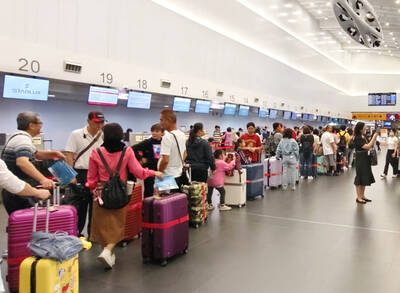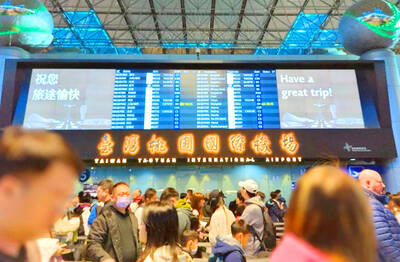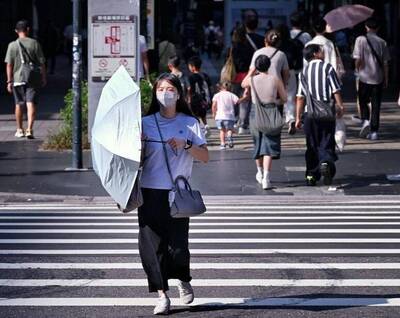Satellite evidence indicating that China has built a “midget” submarine at its Wuchang shipyard in Wuhan might be of particular concern to Taiwan, analysts said.
“If built in significant numbers, small or midget submarines could further expand China’s gathering capabilities to invade Taiwan,” International Assessment and Strategy Center senior fellow Richard Fisher told reporters.
“A large number of small submarines could serve to increase the number of ports that China could attack by air and seaborne special forces,” said Fisher, an expert on China’s military.
IHS Jane’s Defence Weekly and News Corp Australia reported this week that DigitalGlobal satellite imagery has revealed a submarine with an approximate length of 35m and a width of 4m — estimated to displace from 400 to 500 tonnes — berthed at a pontoon used for fitting out submarines in China’s Hubei Province.
“The Wuchang shipyard is at the forefront of conventional submarine production in China,” Jane’s said.
The satellite imagery was recorded late last year, but has just been analyzed and released.
News Corp said the mini sub had not been “seen nor heard of” since the satellite images were made.
It is not known whether the small submarine spotted by the satellite is a one-off production model or part of a much larger fleet.
“Such a submarine is ideally suited to operate in the shallow waters of the East China and South China seas, hiding among the clutter of the seabed and noisy tidal currents,” News Corp said. “While able to carry torpedoes, military analysts believe the primary purpose of these commando submarines is to secretly deploy spies and special forces.”
Fisher told the Taipei Times that in the case of an invasion, the more Taiwanese ports that China can capture, the easier it would be for China’s People’s Liberation Army to use civilian-operated sea-lift capabilities to rapidly increase deployed forces for further operations.
He said that for other nations, China’s development of small submarines presents a considerable proliferation challenge.
“By virtue of their smaller size, they are also cheaper to acquire and maintain, and thus affordable to nations like Argentina, which China appears intent on re-arming,” Fisher said.
Development of small submarines also accelerates China’s ability to develop uncrewed underwater combat vehicles (UUCVs) that could be used for surveillance, targeting, mine-laying or attacking ships, he said.
“It should be expected that future Chinese UUCVs will also be deployed for use against Taiwan,” Fisher said.

Three Taiwanese airlines have prohibited passengers from packing Bluetooth earbuds and their charger cases in checked luggage. EVA Air and Uni Air said that Bluetooth earbuds and charger cases are categorized as portable electronic devices, which should be switched off if they are placed in checked luggage based on international aviation safety regulations. They must not be in standby or sleep mode. However, as charging would continue when earbuds are placed in the charger cases, which would contravene international aviation regulations, their cases must be carried as hand luggage, they said. Tigerair Taiwan said that earbud charger cases are equipped

Foreign travelers entering Taiwan on a short layover via Taiwan Taoyuan International Airport are receiving NT$600 gift vouchers from yesterday, the Tourism Administration said, adding that it hopes the incentive would boost tourism consumption at the airport. The program, which allows travelers holding non-Taiwan passports who enter the country during a layover of up to 24 hours to claim a voucher, aims to promote attractions at the airport, the agency said in a statement on Friday. To participate, travelers must sign up on the campaign Web site, the agency said. They can then present their passport and boarding pass for their connecting international

Temperatures in northern Taiwan are forecast to reach as high as 30°C today, as an ongoing northeasterly seasonal wind system weakens, the Central Weather Administration (CWA) said. CWA forecaster Tseng Chao-cheng (曾昭誠) said yesterday that with the seasonal wind system weakening, warmer easterly winds would boost the temperature today. Daytime temperatures in northern Taiwan and Yilan County are expected to range from 28°C to 30°C today, up about 3°C from yesterday, Tseng said. According to the CWA, temperature highs in central and southern Taiwan could stay stable. However, the weather is expected to turn cooler starting tonight as the northeasterly wind system strengthens again

Taiwan sweltered through its hottest October on record, the Central Weather Administration (CWA) said yesterday, the latest in a string of global temperature records. The main island endured its highest average temperature since 1950, CWA forecaster Liu Pei-teng said. Temperatures the world over have soared in recent years as human-induced climate change contributes to ever more erratic weather patterns. Taiwan’s average temperature was 27.381°C as of Thursday, Liu said. Liu said the average could slip 0.1°C by the end of yesterday, but it would still be higher than the previous record of 27.009°C in 2016. "The temperature only started lowering around Oct. 18 or 19